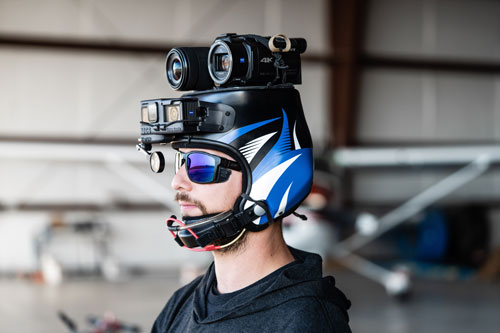A closer look at skydiving glasses
BY RALPH WILHELM (Camera Flyer / Keynote Speaker)
Hi Skydiving Community or let’s call it Skydive Nation!
An important detail of skydiving equipment, but far too often neglected: goggles!
Just imagine you have problems seeing up there while you’re jumping! No view of the altimeter, no view of the landing target. That can quickly become dangerous. All the more important to take a closer look at this small piece of equipment.
There at four reasons for a skydiver to wear glasses. Eye protection from the wind with an open face helmet, correction of a sight debility, sun protection and looking cool. No matter what your reason is, make sure you choose the right glasses. Here is some food for thought.
Oldschool Sunglasses
Inexpensive and easy to replace but definitely not the best google when it comes to protection or if you want to install corrective lenses.
When using an open face helmet, the shape of the glasses, which dictates the fit, is most important. The less wind you get into your eyes, the lower is the risk of temporary losing sight due to watering eyes. If a newbie ask which glasses to buy, people often answer with brand names. That does not really help. Every face has a different form. It’s paramount that the shape of the glasses fits the shape of your face as good as possible. Too much space between the frame and your face equals far too windy, might look cool but these glasses are not suitable for skydiving.
So I went around the DZ and asked everybody who was wearing glasses to let me try his brand. Trying the glasses of another instructor (thanks Jeanine), I found that WileyX fit my face perfectly. However they might not fit your face at all. Most manufacturers have different models for longer or rounder shaped faces. You have to try.
Oldschool Skydiving Glasses
A perfect fit
Different shapes for different faces
Thin temples
Fit
Depending on the shape of your face, some glasses will sit nicely tight.
Shapes
Most manufacturers offer different shapes. So try to find those glasses which fit your face best.
Quite important is the thickness of the temples. Thick temples are a pain (in the face) when you put the glasses on while wearing a full face helmet, and can cause discomfort and pain when wearing an open face helmet, as the temples are pressed against your skin/skull by the helmet. Remember you might sit quite a time with your helmet on during the way to altitude and on the way down under canopy. It sounds a bit unusual, but bring your helmet if you tryout the glasses for fit. They might fight perfectly without the helmet but may be hard to get on when wearing a full face helmet or may cause discomfort when wearing them under the helmet for a longer time.
Thin temples
Test the glasses with your helmet for a longer time, as putting them on might be tricky and wearing them longer might hurt if the rim of your helmet presses the temples against your skin.
Another nice to have point if you are using an open face helmet is if the glasses are set up for the use with a neckband. As you do not want to lose your glasses in freefall, the use of a neckband is strongly recommend. Some brands depend on aftermarket slip over neckbands. I don’t like this solution, as these neckband are not so easy to install or remove and I don’t need a neckband when driving a car or just doing something different than skydiving on a sunny day (what a strange thought). I prefer glasses where the temples are set up in a way that you can snap a neckband on and off in no time.














Leave a Reply
Want to join the discussion?Feel free to contribute!